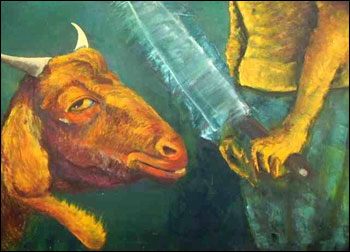 The man who gave us those iconic Stop and Eject signs was not into art for art's sake. For him, it was a way of life. Instep pays tribute to a rare shooting star... The man who gave us those iconic Stop and Eject signs was not into art for art's sake. For him, it was a way of life. Instep pays tribute to a rare shooting star...
He was perhaps the brightest and most vibrant painter in Karachi of the new generation. Asim Butt, could definitely paint and how, but it was his dynamic symbolic art done on a whim on the streets that grabbed everyone's attention. More than an artist fraternizing with the hoi polloi, he was an artist who liked to observe life at places like Abdullah Shah Ghazi's mazar and paint murals on walls that that would be wiped out by the less artistically sensible authorities of the city. People close to him say that it broke his heart, whenever that happened, but even so he soldiered on. For Asim Butt, art was more than earning a livelihood and no one can say why he painted more eloquently than him.
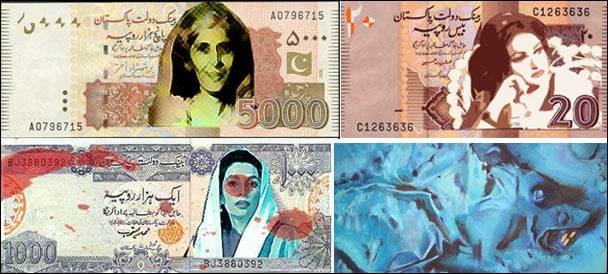
"I paint because it allows me to stare shamelessly, to be able to flesh out an idea, emotion, or commit to an image a shadow of the world around me. I paint because there is a spillover of energy within that must find form or else it will haunt and twist me. I paint to commit an act of magic and pleasure, for myself, for the love of my audience, and for an abstract notion of my muse's gaze. I paint to validate my Self and to discover surprises within and without. I paint as a penance for my inadequacies. I paint to understand the world around me and to own and disown what I desire or dislike in it. I paint as a political act: to express my power over power larger than myself. I paint to create what it is I want to see, to fill an absence in the world. I paint in conversation with other images, words and music that require, comment, critique or tribute."

Street art
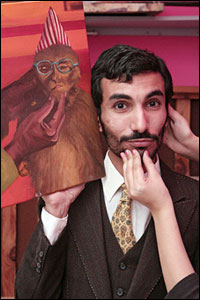 They called him the Banksy of Pakistan after the hit and run graffiti artist of Britain. Asim loved painting on walls on the streets. He painted heartfelt murals near monuments like Abdullah Shah Ghazi's mazaar. And then there were the sporadic bursts of inspiration that came from his gut as an activist, like painting STOP in bright blood red on the wreckage of cars after the riots that followed Benazir Bhutto's assassination or eject signs right after Musharraf imposed emergency. They called him the Banksy of Pakistan after the hit and run graffiti artist of Britain. Asim loved painting on walls on the streets. He painted heartfelt murals near monuments like Abdullah Shah Ghazi's mazaar. And then there were the sporadic bursts of inspiration that came from his gut as an activist, like painting STOP in bright blood red on the wreckage of cars after the riots that followed Benazir Bhutto's assassination or eject signs right after Musharraf imposed emergency.
Asim recounted these exploits with glee.
"With some kind of french rap egging you on, park your car in a place where you can make a dash for it, carry your stuff in a back pack and pretend that you're in a video game. I did the police piece over two nights at three spots within a kilometre of each other, running through Saddar in the dead of the night. First night i turned 'police' into 'lice'. I was hollered down by the police the second night I went to layer the Club Road piece but just relocated by first of course making a dash for the car, which had been strategically parked."
It must've been such fun outwitting the dreaded 'lice'!
20/20 banknotes: Benazir Bhutto, Noor Jehan and Fatima Jinnah
Asim Butt was whimsical by nature. These digital collages he made of bank notes he wished existed were a huge hit, featuring three iconic women in our history. Yes, it was an obvious way of saluting them, but Asim was never likely to give you and earnest, boring answer. "I'm tired of looking at the father of our nation on banknotes," said the skinny artist, "I see him in the mirror too you see, though admittedly minus the headgear."

Humour was as much a part of Asim's person person as it was of his art, that always drove a point home or cracked a joke. He made art to react to, not just to admire.
S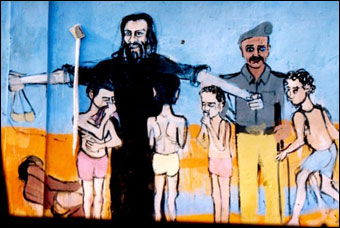 tuckism tuckism
Asim Butt co-founded the Karachi Stuckists Group in 2005. So what is Stuckism?
"Your paintings are stuck, you are stuck! Stuck! Stuck! Stuck!" Stuckism movement's co-founder (and ex-member) Billy Childish's girlfriend, Tracey Emin had told him. And Charles Thomson, the other founder had used this to coin the name 'Stuckism'. Stuckists would simply like to see figurative painting used as a vehicle for ideas, rather than the more modernist conceptual art that can take the form of pretty much anything. Stuckism has further expanded since its 1999 manifesto to include printmaking and sculpture into its folds - but maintains that "artists who don't paint aren't artists," and "sculptors who don't sculpt aren't artists."
Anybody familiar with Asim's work will see him having more of a proclivity towards true representations of the things he painted rather than leaning toward representations more conceptual and abstract. And while he took on the mantle of being a proponent of Stuckism, he wrote to a fellow Stuckist based in Tehran in an email that "the idea of stuckism doesn't really have a formal movement behind it in Karachi. It's basically just me who is flying the banner although a lot of people are doing Stuckist painting."
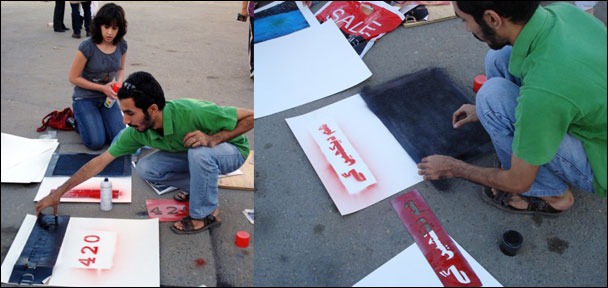
Carcass
"I painted this because I came across (a dog's carcass) on a beach, half-buried, beginning to dessicate into fossil," he said.
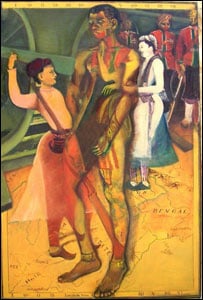 After Asim's demise, Imran Khan from Al-Jazeera wrote on this in a tribute to him on their blog: "One of his works will always stay with me. While walking along the beach on Karachi's seafront, he came across the carcass of a decomposing dog. Asim was gripped by it. In the end he did a series of paintings, each one more haunting than the next. The dog paintings represent a window into this young man's vision of the world. Asim had an eye for detail, details that often came out in his work." After painting the carcass, Asim cheered himself up by making a barking dog cartoon! After Asim's demise, Imran Khan from Al-Jazeera wrote on this in a tribute to him on their blog: "One of his works will always stay with me. While walking along the beach on Karachi's seafront, he came across the carcass of a decomposing dog. Asim was gripped by it. In the end he did a series of paintings, each one more haunting than the next. The dog paintings represent a window into this young man's vision of the world. Asim had an eye for detail, details that often came out in his work." After painting the carcass, Asim cheered himself up by making a barking dog cartoon!
Contempt
The attitude of Contempt is delightful. Drawing on the very Pakistani ritual of slaughter, it features a sardonic goat who Asim obviously took wicked delight in painting. "The bakra's like 'go ahead, make my day!' Contemptuous and resigned," said Asim of this striking work. "This painting had Bhutto and Zia to start out but this is the way it turned out. I don't like being directly political. The knife vibrating is a technique used by Francis Bacon."
Cohabitation
A close observer of nature, like one of his favourite painters Van Gogh, Asim painted this work based on a photo he had taken. In the artist's own words, "It's about symbiosis between bird and beast. The crow represents something quite sinister usually and appears in Sadequain's work repeatedly in a nest of thorns he wears in his self-portraits. Here the crow, fierce as it may be, is perhaps more benign."
|

